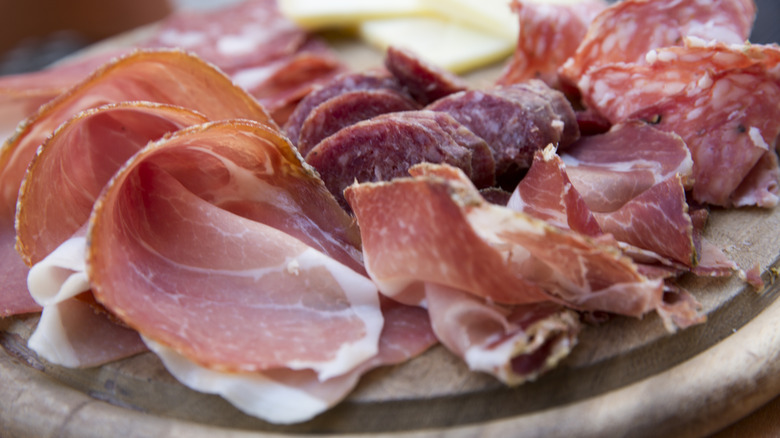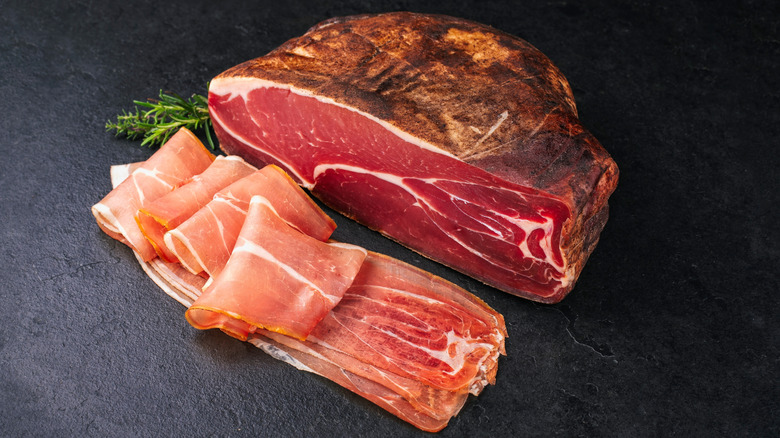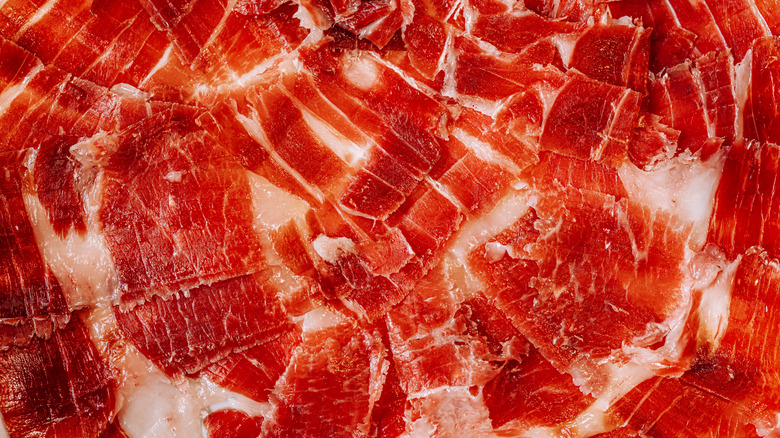Is Prosciutto The Same Thing As Jamón?
If you aren't familiar with just how many different types of ham there are out in the world, prosciutto and jamón should be the two starting points on your exploration of just what people can do with a pig. Prepared from the rear legs of pigs that are cured or smoked, the common American conception of ham is mostly that sweet pink deli meat, and its similar variations like Black Forest. But some countries in Europe take their ham even more seriously. There are all kinds of regional variations that involve extended aging times, locally specific breeds of pigs, and strict diets that produce some of the most unique and flavorful meat on the planet. And of all those European products, jamón and prosciutto stand out as two of the most special.
Despite jamón just being Spanish for "ham," it's not quite the catch-all term that the word is in English. Instead it refers to a specific style of aged ham that comes in a few varieties, with jamón serrano and jamón Ibérico being the best known. While similar to the Italian prosciutto it is certainly not the same thing, or even inclusive of it. They are both types of ham, but the specific local ingredients used to make them are different, as is the aging process, giving each a distinct flavor and texture. That's what makes jamón and prosciutto such a great introduction to what makes a specific type of ham special.
What is prosciutto?
Like jamón, prosciutto is actually just Italian for the word ham and includes several different regional styles from the country. The prosciutto most Americans know is a pork leg that has been dry-cured in salt and aged. The leg is rubbed and left to cure in salt for several weeks, and then goes through a two-step aging process. First it is hung in a moist, cool room for 60 to 90 days, and then prosciutto goes through a longer rest that can be anywhere between nine and 36 months in a drier environment. That second step is done in rooms that are open to outside air, with the breezes helping dry the ham. The humid aging step is unique to prosciutto and is part of what gives its special texture and flavor, which is softer and sweeter than other aged hams.
There are different types of prosciutto, like prosciutto Toscano, which is made with the addition of local herbs, or the fatty Prosciutto di San Daniele, but the most famous and popular is Prosciutto di Parma. This style of prosciutto may only be made around Parma in the Italian region of Emilia-Romagna. It can also only be made with Italian-born pigs of two distinct breeds, which are fed a diet of local products including corn, barley, and the whey left over from the production of Parmigiano Reggiano cheese. This gives Prosciutto di Parma a distinctly balanced flavor that mixes buttery richness with salty, sweet, and earthy notes.
What is jamón?
Jamón is a cured and air-dried pig's leg made in a distinct Spanish fashion. Jamón serrano is the more common, accounting for 90% of Spanish ham production. It's made from Spanish breeds of white pig, which are fed a grain-based diet. Then there are two special distinctions in the aging process compared to prosciutto. First, jamón serrano is aged drier, and at the end it is moved to a warmer environment which actually rancidifies the outer layer of fat. While the aging period is similar to prosciutto, jamón is usually aged longer, 12 to 18 months for serrano, compared with an average of nine to 14 for prosciutto. The aging process for jamón serrano gives it a drier texture and more intense complex flavor that is more nutty, woody, and gamy than prosciutto.
Jamón ibérico is the rarer and more expensive style. In fact, it's the world's most expensive cured meat. Serrano can be made anywhere in Spain, but jamón Ibérico is from only four regions in southwestern Spain, made with a different breed of black Iberian pigs. These pigs free roam and eat local forage, including grass and herbs, before being finished on local acorns. The aging process is even longer than serrano, at least two years. The distinct diet gives that intense flavor with more nuttiness and sweetness, and the richer texture of prosciutto, which is why it's such a prized ham.


